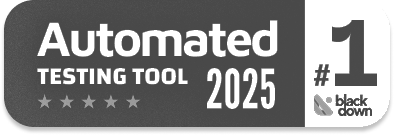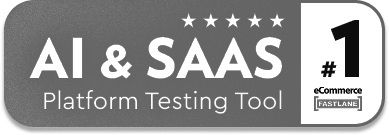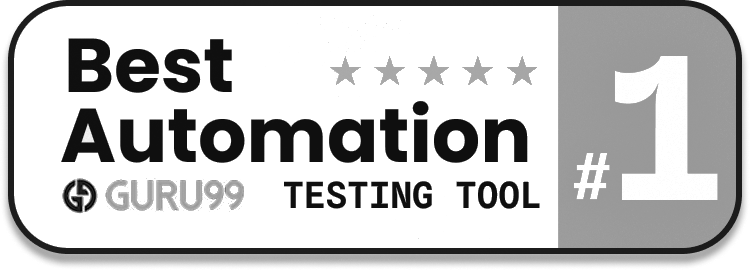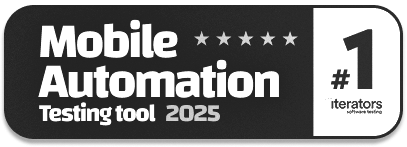What is Automation-First Mindset?
|
|
Today, software delivery timelines are getting shorter, and operational efficiency is a top priority. Organizations are now embracing automation as not just a tool, but also a way of doing things. This is the new paradigm we can see described by the Automation-first Mindset. Instead of being an afterthought available if manual processes have not worked out or if they have become too routine, automation-first considers automation a fundamental part of planning, designing, and performing workflows.
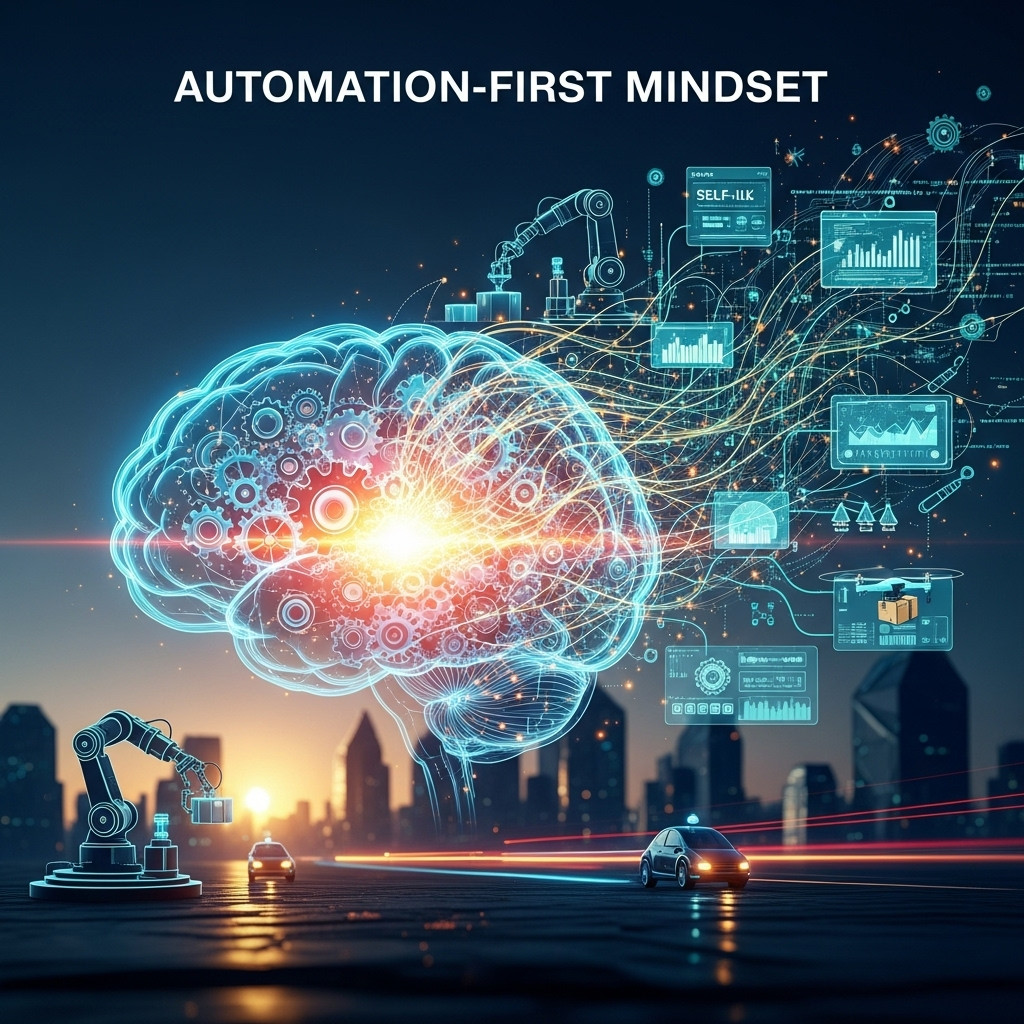
Automation-first is not just about tooling and scripts; it is a cultural and strategic approach that enables teams to think automation first, reuse solutions, and scale processes with minimal human involvement. As organizations become more digitally mature, it is critical to develop an automation-first culture not just to compete but to innovate and scale with confidence in a dynamic technological environment.
| Key Takeaways: |
|---|
|
What is an Automation-First Mindset
An automation-first mindset is a proactive philosophy that views automation as the default solution to operational, development, and business problems. Instead of seeing automation as a last resort, when manual processes are no longer efficient or sustainable, this approach will help teams to start every initiative with automation as a strategic objective on day one. The automation-first approach at its core encourages a culture of repeatability, scalability, and efficiency as core design principles. It makes teams question, “How can we automate this?” before accepting any manual process.
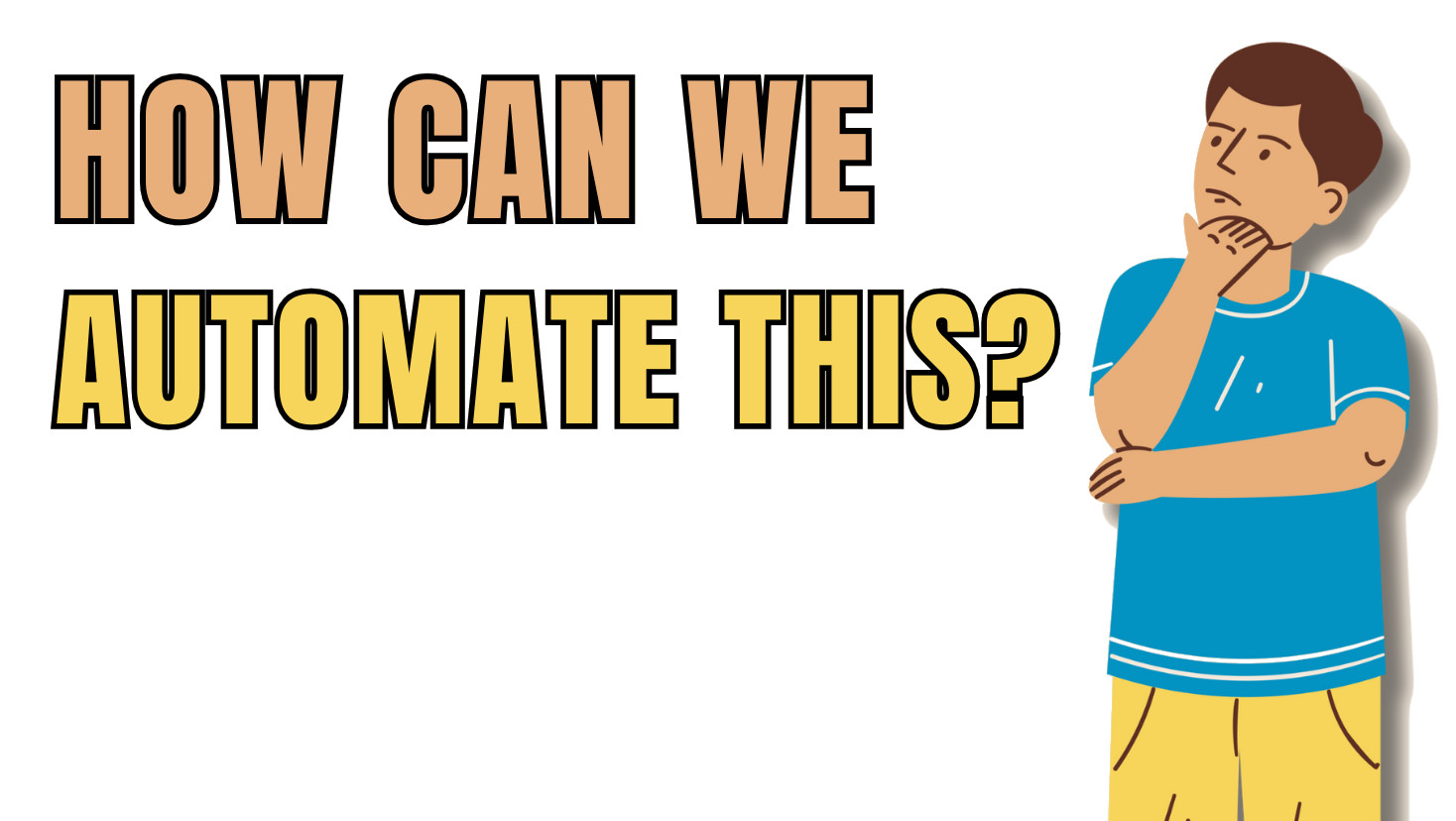
It is not just about implementing automation tools but about building a common understanding that automation brings long-term value, reduces risk, and speeds up delivery. This attitude covers a wide range of fields from DevOps, testing, infrastructure, and security to business process automation. It makes technology choices business-driven by reducing human intervention, enhancing compliance, and delivering faster and more reliable delivery pipelines.
The Evolution of Automation Thinking
Automation was not always as strategic as it is now. Its application has changed dramatically in the last few decades. It is no longer a reactive instrument applied in extreme situations but a proactive and default strategy integrated throughout organizations.
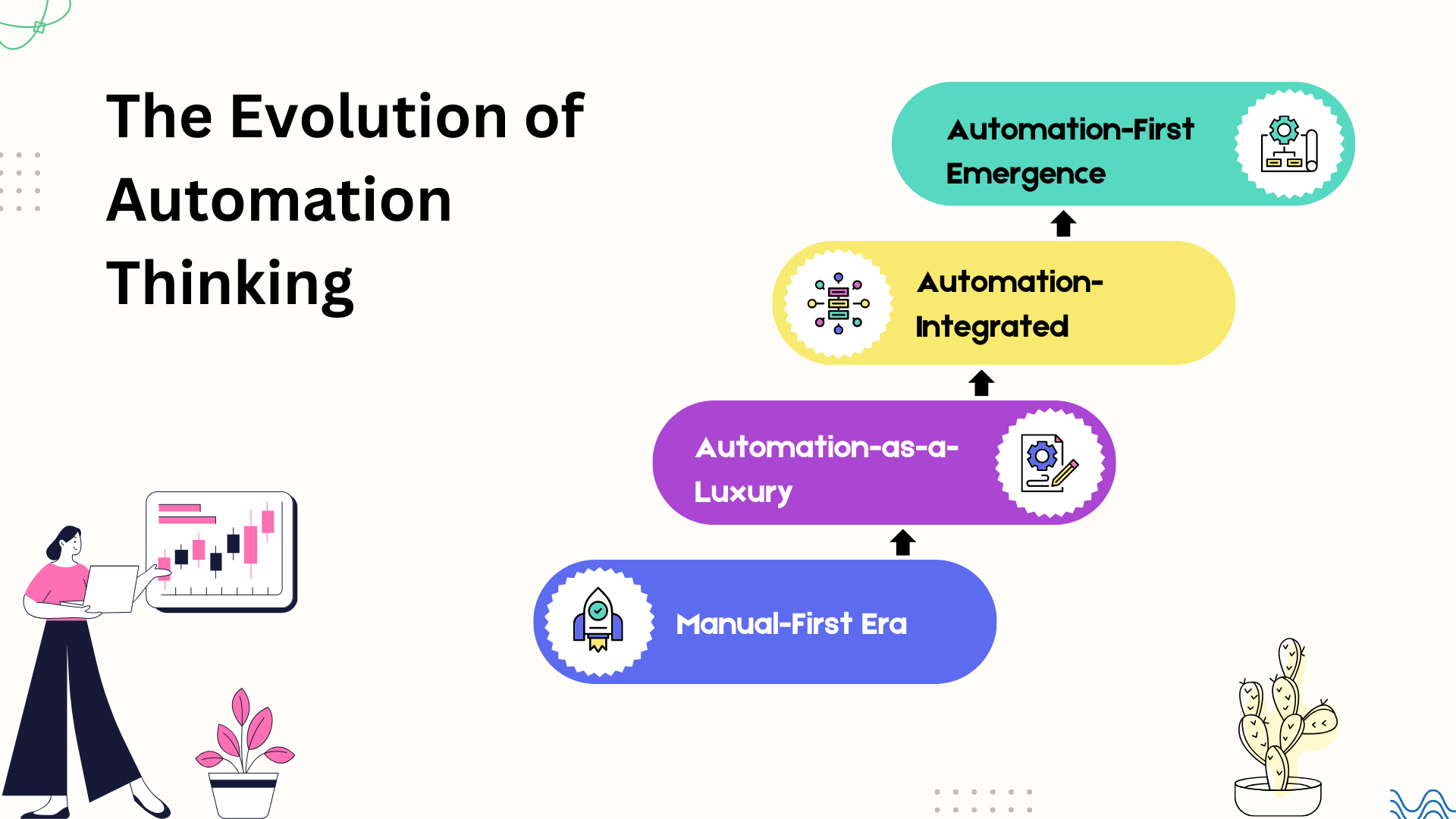
Manual-first Era
Manual execution was the norm in the early phases of software and systems development. Deployment, testing, monitoring, and configuration were performed by human operators. Although this method provided teams with complete control and visibility, it also created a lot of inefficiencies, human error, and bottlenecks. Repetitive tasks were time-consuming, and scalability was low. Automation was either absent or limited to highly specialized functions.
Automation-as-a-Luxury
As organizations grew, automation started to be considered, but it was still viewed as a nice-to-have, not a must-have. Teams would tend to justify automation only on processes that were very time-consuming or error-prone. The tools were scarce, integration was challenging, and automation was expensive in terms of time and expertise. Therefore, automation was introduced in isolated areas, not as a strategic plan.
Automation-integrated
Automation became more available and integrated into everyday workflows with the emergence of Agile, DevOps, and CI/CD pipelines. Teams began to embrace test automation, infrastructure as code, and automated deployments as a part of their delivery lifecycle. Instead of being a post-deployment add-on, automation started to assist every phase of the SDLC. Nevertheless, it was still used in a reactive manner- after processes were established and matured, then automated.
Automation began to be the rule, but not the beginning. Read: STLC vs. SDLC in Software Testing.
Automation-first Emergence
The latest development is the transition to an automation-first approach, where automation is not an addition but a given. Rather than waiting to manually demonstrate that a process is working before automating it, teams are now building automation at the ground level in testing, deployments, monitoring, security, and business operations. Cloud-native infrastructure, DevSecOps practices, AI/ML tooling, and scalable frameworks have all enabled the ability to automate intelligently and iteratively at the outset.
Pillars of an Automation-first Mindset
Automation-first is not merely a concept, but a framework with principles that teams and organizations can use to guide their operations. These pillars are the backbone of an effective automation-first strategy, where automation is intentional, scalable, and culturally integrated.
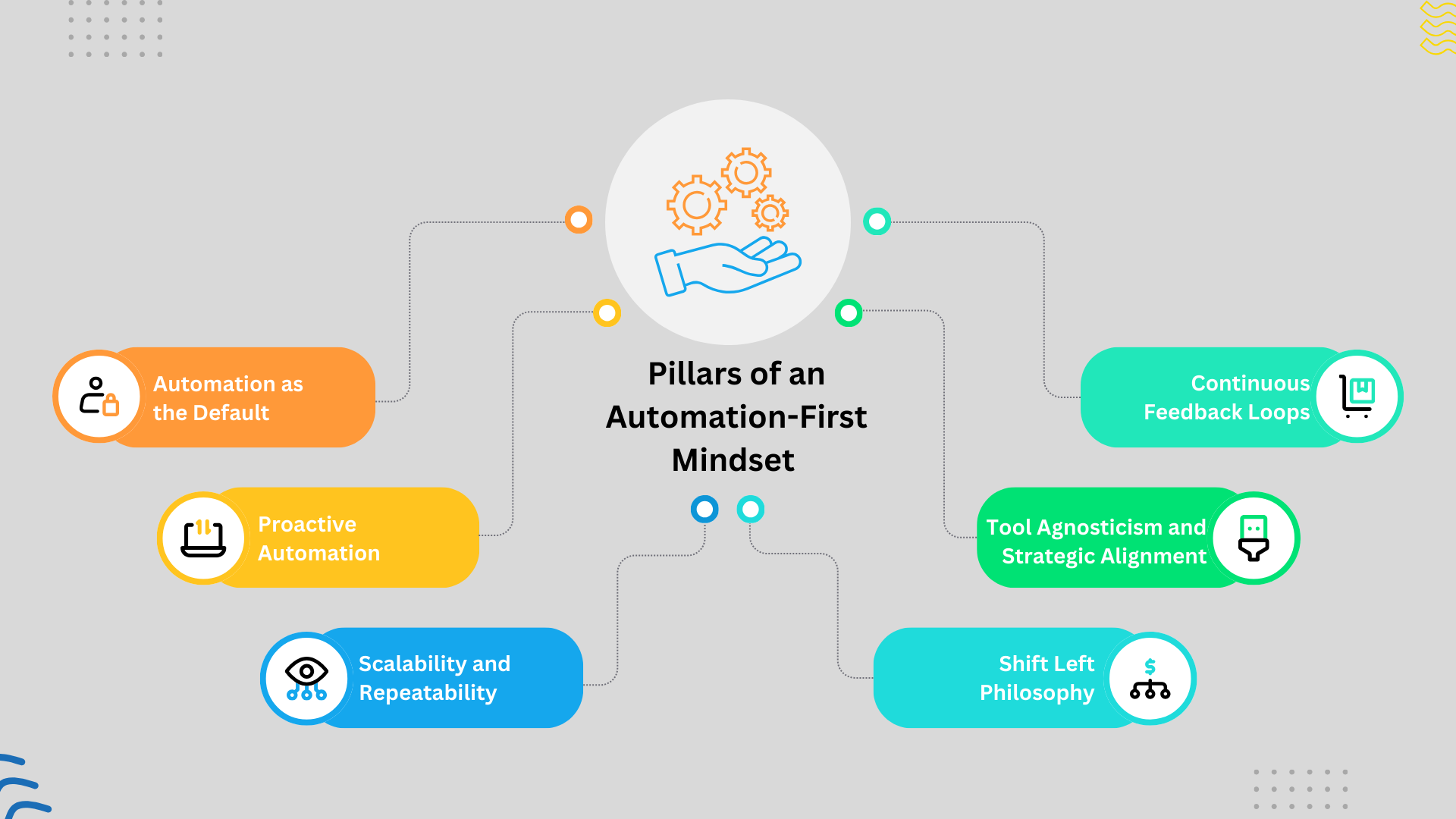
Automation as the Default
This pillar focuses on the fact that all tasks must be viewed as potential candidates to automation. The default question should be: “How do we automate this?” Manual processes are only taken into consideration when automation is technically impossible This attitude minimizes human error, maximizes efficiency, and preconditions the possibility of scaling operations quickly.
Proactive Automation
Proactive automation involves automating processes that are repetitive or prone to failure before they can cause issues. Teams no longer respond to inefficiencies or outages, but instead design systems to anticipate known patterns. For example, auto-scaling infrastructure with predictive workloads or automating compliance checks during development can help avoid bottlenecks and firefighting.
Scalability and Repeatability
Automation should not only be functional but also scalable and provide consistent results. A script that automates a task in one environment is helpful, but an automation-first approach means that it can be reused across environments, projects, or teams. Standardization, parameterization, and modularity are essential elements that allow organizations to scale without re-inventing the wheel.
Shift Left Philosophy
The shift left principle is part and parcel of automation-first thinking. It entails shifting automation tasks, such as testing, security scans, and infrastructure validation, earlier in the development cycle. This results in quicker feedback, earlier identification of issues, and reduced costs of remediation. For example, security misconfigurations or test failures can be caught by developers before code ever reaches staging. Read more: Shift Left Testing – Software Testing Done Early.
Tool Agnosticism and Strategic Alignment
An automation-first approach prevents tool blindness. Rather than relying on one vendor or platform, teams select the best tools to get the job done, with an emphasis on interoperability, flexibility, and alignment with business objectives. This strategy will make it flexible to changing technologies, avoid vendor lock-in, and encourage innovation as teams can experiment with the best-of-breed solutions.
Continuous Feedback Loops
Automation is not just plug-and-play. Mature automation-first teams have continuous feedback loops where data generated by automated processes is analysed and used to refine, optimize, or even replace automation workflows. Monitoring, observability, metrics, and user input are all fed back into the system to make sure that automation is relevant, efficient, and high-impact in the long term. Read: Continuous Integration and Continuous Testing: How to Establish?
Where the Automation-first Mindset Applies
The automation-first mentality is not restricted to a particular area or position. Its principles can be applied to a broad spectrum of technical and business areas, and they can be used to achieve consistency, speed, and efficiency within an organization.
Software Testing
Testing is one of the most developed fields of automation in modern development. An automation-first approach to software testing will guarantee that:
- Unit, integration, and regression tests are executed on every code change.
- Testing is owned by shift-left strategies.
- Bugs are identified early, which makes it cheaper to fix them.
- Test suites are repeatable, scalable, and part of CI/CD pipelines.
Infrastructure as Code (IaC)
The process of infrastructure provisioning has evolved to be automated declarations rather than manual configuration with tools such as Terraform, Ansible, or AWS CloudFormation. Through an automation-first strategy:
- Infrastructure is version-controlled, codified, and peer-reviewed.
- Environments may be created and deleted on demand, minimizing overhead.
- There is consistency between dev, staging, and production environments.
- Scaling is made seamless, and there is no drift.
Read more: What is Infrastructure as Code (IaC)?
Deployment Pipelines
Automation is the lifeblood of rapid delivery, and it ensures:
- Automatic building, testing, and deployment of code changes across environments.
- Rollbacks and roll-forwards occur with little human intervention.
- Pipelines have approval gates, static analysis, artifact management, and canary deployments.
- Deployment is predictable and auditable, and frequent releases can be made with less risk.
Security (DevSecOps)
Security automation, particularly in the DevSecOps framework, integrates security into the development process. An automation-first approach:
- Pipelines include static (SAST) and dynamic (DAST) security scans.
- Dependency vulnerabilities are detected and patched automatically.
- Policy enforcement, secret rotation, and access control are automated.
- SOAR platforms and auto-remediation playbooks are used to speed up response to incidents.
Read about: The Role of QA in DevSecOps.
Monitoring and Alerting
Automated observability is of great benefit to operations teams. This includes:
- Real-time monitoring systems with alerting thresholds and anomaly detection.
- Auto-scaling and self-healing based on system metrics.
- Dashboards that dynamically indicate the health of systems and services.
- Integration with incident management tools to automatically create tickets and escalate.
Business Processes
In addition to engineering, automation-first principles can improve operational efficiency in:
- Human Resources (e.g., automated onboarding workflows).
- Finance (e.g., invoice processing, reconciliation).
- Customer Support (e.g., chatbots, automated ticket triage).
- Marketing (e.g., campaign triggers, analytics pipelines).
- RPA (Robotic Process Automation) tools and custom automation scripts automate repetitive processes, allowing employees to focus on more valuable tasks.
Characteristics of Teams with an Automation-First Mindset
| Characteristic | Description |
|---|---|
| Proactive Problem Solvers | Teams anticipate bottlenecks and automate to prevent them rather than reacting after issues arise. |
| Automation-centric Design Thinking | Solutions are designed with automation in mind from the beginning and are not added later as enhancements. |
| Cross-functional Collaboration | Developers, testers, ops, and security teams work together with shared automation goals. |
| Tool Agnosticism | Teams choose the best tools for the job, focusing on integration and flexibility over brand loyalty. |
| Data-driven Decision Making | Feedback loops, metrics, and observability guide improvements in automated workflows. |
| Version Control for Everything | Code, infrastructure, documentation, and automation scripts are stored in repositories. |
| Emphasis on Reusability | Automation scripts and templates are modular and reused across projects and teams. |
| Culture of Continuous Improvement | Automation is regularly reviewed and refined for efficiency and effectiveness. |
| Security & Compliance Embedded | Automated checks for security, policy compliance, and audits are integrated in early stages. |
| Blameless Postmortems | Failures in automation are treated as learning opportunities to improve processes. |
How to Build an Automation-First Culture
Creating an automation-first culture is not just about tools, but also about leadership commitment, clear objectives, upskilling, and reinforcement throughout the organization. The following are some of the main strategies to make this shift successful.
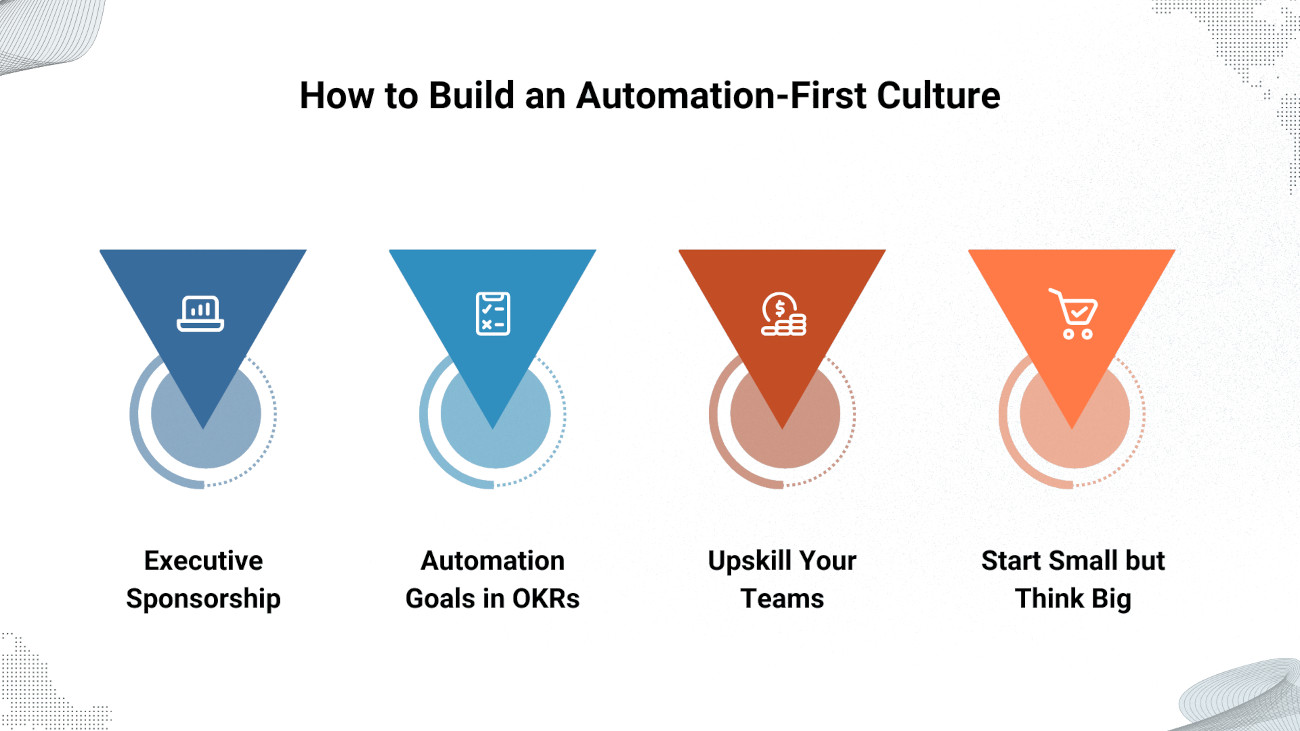
Executive Sponsorship
Automation projects require top-down sponsorship. Executive sponsorship guarantees budget, tools, and time to work on automation. Transparency between departments, promotes alignment and adoption. Also, elimination of roadblocks leads to cross-team initiatives. Top-down culture-setting, makes automation a strategic priority, rather than a technical exercise.
Automation Goals in OKRs
To integrate automation into everyday processes, it must be reflected in Objectives and Key Results (OKRs).
Set quantifiable objectives such as reducing manual deployment effort by 80 percent in Q3 or automating half of the test cases within the next two sprints. Automation progress should be monitored as part of performance reviews and strategy dashboards. Read more: How to Setup OKRs Properly.
Upskill Your Teams
A culture of automation first needs to be continuously learned. Organize internal workshops, hackathons, and brown-bag sessions. Promote certifications and practical learning environments.
Start Small but Think Big
Start automation projects with high-impact, low-complexity areas. Automate routine tasks such as report generation, deployments, or daily status emails. Demonstrate value by creating early wins. Share success stories and scale automation over time across projects and departments. Establish a scalable base (modular code, shared libraries, CI/CD pipelines) early on.
Common Challenges with an Automation-first Mindset
The automation-first approach is a game-changer, yet not without challenges. Most organizations encounter cultural, technical, and strategic issues when integrating automation into their workflows. Being aware of these roadblocks is important in order to deal with them in advance.
- Cultural Resistance: Employees can feel that automation threatens their jobs, which can result in passive or active resistance. Teams that have been used to manual processes may be reluctant to change established workflows, even when inefficient.
- Skill Gaps: Automation may involve expertise in scripting, DevOps tools, or testing frameworks. Most teams do not have adequate training or resources to skill up. Teams can become over-dependent on a few automation specialists, leading to bottlenecks and burnout.
- Poor Tooling or Fragmentation: Having too many unrelated tools results in redundancy of efforts or incompatible automation strategies. Selecting tools that are not strategically aligned leads to vendor lock-in, scalability problems, or the inability to integrate with other systems.
- Short-Term Orientation: Other organizations consider automation as a one-time activity rather than a continuous process, which leads to stale scripts, technical debt, and brittle systems.
- Security and Compliance Issues: Automation scripts that are not securely coded may leak credentials, APIs, or other important systems. Auditors might be reluctant to accept automated changes without proper logging and traceability. Read more: Security Testing.
Automation-first vs. Automation-ready vs. Manual-first
| Aspect | Manual-First | Automation-Ready | Automation-First |
|---|---|---|---|
| Philosophy | Tasks are performed manually unless there’s a compelling reason to automate | Automation is planned but implemented gradually | Automation is the default approach from the beginning |
| Trigger Point | Reactive (after problems or scale issues occur) | Proactive planning, but implementation depends on time/resources | Proactive and strategic, integrated into project goals |
| Tool Adoption | Minimal; often ad hoc or outdated | Tools are selected but inconsistently used | Tool usage is intentional, standardized, and integrated |
| Process Design | Manual-centric workflows | Designed with automation in mind, but allows for manual steps | Designed from the ground up for full automation |
| Team Skills | Basic scripting, mostly manual knowledge | Teams possess moderate automation and tool proficiency | High level of skill in scripting, CI/CD, DevOps, and automation frameworks |
| Onboarding | Focuses on manual processes | Introduces automation later in the cycle | Automation tools and workflows introduced during onboarding |
| Testing & CI/CD | Manual testing and deployments | Partial CI/CD pipelines | Fully automated CI/CD with integrated testing |
| Scalability | Poor; scales linearly with effort | Moderate scalability | High scalability; repeatable and reusable automation |
| Security & Compliance | Often reactive and manually tracked | Some automation of compliance tasks | Security and compliance checks are automated and shift-left |
| Culture | Resistant to change | Accepts change but lacks full buy-in | Embraces continuous improvement and automation-driven thinking |
| Decision Making | Based on experience and manual judgment | Data is considered, but not always used consistently | Data-driven, with metrics from automation guiding decisions |
Future of the Automation-First Mindset
The automation-first mentality is no longer a mere operational advantage, but it is quickly becoming a strategic requirement. Automation will become a strategic pillar of business and technology strategies as digital ecosystems become more complex and the need to be fast, reliable, and scalable increases.
Integration with AI and Machine Learning
The future of automation will be intelligent automation, which uses AI to make decisions, learn patterns, and optimize workflows without human intervention. Bots powered by AI will examine the behaviour of the system, identify anomalies, and automatically modify pipelines, test cases, and infrastructure settings.
Example: AI models can be used to determine which test cases are most likely to fail and prioritize them in CI/CD. Infrastructure scaling and self-healing systems will be the standard.
Hyper Automation Enterprise-wide
Hyper automation, which is the integration of several automation technologies such as RPA, AI, and process mining, will allow the automation of entire business processes. The aim is to minimize human intervention to the bare minimum in all functions. Traditional DevOps tools will be complemented by business process automation (BPA) and robotic process automation (RPA). All manual handoffs in workflows (e.g., HR onboarding, compliance audits, customer service ticketing) will be candidates for automation. Read more: Process Automation.
Infrastructure and Code as Immutable Assets
The future is immutable infrastructure and declarative systems, where infrastructure, configuration, and workflows are specified once and automatically replicated without drift or manual patching. GitOps, policy-as-code, and everything-as-code will be the norm.
Final Thoughts
The automation-first approach is a paradigm shift in the way organizations think about efficiency, scalability, and innovation. Instead of viewing automation as an add-on or a supplement, it becomes the standard operating mode, ingrained in every decision, workflow, and team culture. With this mindset, organizations can eliminate manual toil and errors and speed up delivery in both technical and business areas.
For today’s technological environment, automation-first thinking is not only the future but the present necessity. Organizations that embrace and cultivate this philosophy will be in the best position to lead in efficiency, agility, and competitive advantage.
| Achieve More Than 90% Test Automation | |
| Step by Step Walkthroughs and Help | |
| 14 Day Free Trial, Cancel Anytime |



